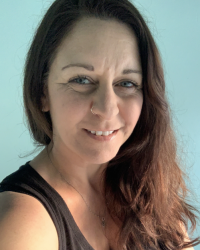How being creative can promote positive mental health
Do you remember when you were little and would spend hours colouring in or cutting out shapes from a piece of paper? Can you remember that feeling of just zoning out and becoming totally engrossed in the process of whatever you were doing? Maybe you liked doodling flowers or shapes; maybe you liked building with Lego or finger knitting, or even writing stories just for fun. As a child, I would spend hours making daisy chains, concentrating so hard on threading each one on to the next to see how long I could make it. I was totally lost in my own little world!

Research has shown that this 'zoning out' or being 'in flow' as it is sometimes called is wonderful for improving brain function, reducing anxiety, lowering depression and aiding better sleep. When we engage in repetitive motions like knitting, sewing or drawing, the flow state is activated and as we begin to produce something, be it a drawing, a knitted garment, or a Lego tower, our brains rejoice at seeing the results of what we have created and a hit of dopamine (the feel-good chemical) gets released, making us feel happy. This dopamine hit drives us to want more of the feeling and helps motivate us to seek more of this type of behaviour.
It's been shown that creative activities amongst dementia patients have had proven positive results too, reducing depression and isolation and helping patients to feel more connected to their personalities while sharpening their senses.
Human beings have been creating since the dawn of time - think of cave paintings left behind by our ancestors or even before that in Africa when it is believed that the origins of our creative endeavours began with body decoration; colouring the skin with ochre and using beads.
Our ability to use our imaginations is what sets us apart from other animals and human creativity is responsible for shaping the world as we know it from beautiful architecture to exquisite works of art. Yet for so many of us, our creative side seems to die when we leave school and grow into adults.
Have you ever wondered where the creative, playful fun part of you went? I believe it's still in there - lying dormant perhaps, as life has taken over and the weight of grown-up responsibility has taken its place and hindered our ability to tune in to this part of ourselves.
But I'm not artistic!
A common misconception among people is that we have to be 'arty' to be creative. This is so not true! Don't get me wrong - it's fabulous if we are talented and able to produce something spectacular and breathtaking, but being creative doesn't always have to be about what we produce; it can be about the creative process itself. It's about being absorbed and tuning out from our worries. It's about being in such a relaxed state that we forget about what's going on in our busy world and we focus solely on the present moment.
This attention to the 'here and now' is the same thing that is achieved through meditation. It's about slowing down, breathing, using our hands and senses and awakening different parts of the brain.
So, what are the benefits?
- reduction of stress and anxiety
- a sense of purpose
- feelings of accomplishment and pride
- can link with others in a shared passion
- improved focus
- better sleep
- promotes thinking and problem solving
- promotes healthy risk-taking
- encourages life-long learning
- allows freedom of expression
- allows you to have fun
- promotes a sense of peace and inner calm
It can be a liberating experience, especially if no one else will get to see (or judge) what we've made or produced! We can be totally free to express parts of ourselves that perhaps we keep hidden from the world.
Ways to be creative
There are many different ways to get creative from adult colouring books to knitting, baking, dotting, marbling, crocheting and many things in between. There are countless YouTube videos which are free to watch if you fancy learning a new skill. Here are just a few ideas to get you started:
- drawing
- painting (painting by numbers is great!)
- doodling
- colouring in
- photography
- baking/cooking
- gardening
- dancing
- crafting (there are a million different crafts to have a go at from card making, zentangle, marbling, dotting, jewellery making, decoupage, collaging, scrapbooking, origami plus loads more)
- singing (why not join a choir?)
- Puzzles
- writing (stories or poems- or maybe even a novel!)
- cake decorating
- cross-stitch
- flower arranging
- podcasting (for the brave amongst us - have your say on issues that are important to you, or share your expert knowledge with others!)
- upcycling (turn old clothes into new designs or give tired pieces of furniture a new lease of life.)
These are really just the tip of the iceberg! There are so many creative activities to get involved with and with such a long list of benefits, now's the perfect time to embrace your inner Picasso or Adele!
With many of us struggling right now with our mental health, and problems in our world that affect so many of us physically, emotionally, mentally and spiritually, we need now more than ever to focus on self-care and find cheap and effective ways of taking matters quite literally into our own hands.
Why not add being creative to your mental health 'tool kit' and see how it can help you?

Find the right counsellor or therapist for you
All therapists are verified professionals
